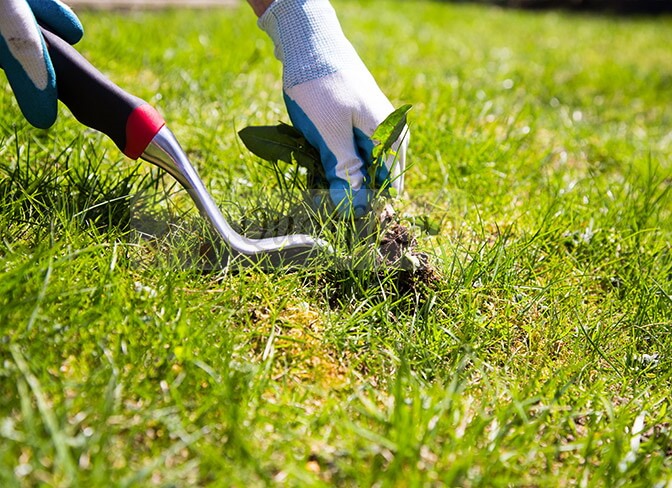Get Rid of Weeds in Your Lawn – Complete DIY Guide

Weeds can be a nuisance on your lawn. Not only do they make your yard look unkempt, but they also compete with the grass for nutrients and water. If you don’t get rid of them soon enough, weeds may even take over the entire lawn.
There are a few ways to get rid of weeds in your lawn: you can use herbicides, pull them out by hand, or cover them with mulch. If you’re looking for a more natural approach, consider using vinegar or boiling water.
No matter which method you choose, be sure to act quickly, the longer you wait, the harder it will be to get rid of them.
We’ll discuss some of the most effective ways to remove weeds from your lawn. So, keep in touch until the end.
Effective Ways to Kill Weeds
Pull Them Out
One of the simplest ways to get rid of weeds is to pull them out by hand. This may be a time-consuming process, but it’s effective and safe for your lawn.
If you’re looking to remove a large number of weeds at once, try using a garden hoe or weed wrench.
Cover Them with Mulch
Mulching is a great way to keep weeds from growing in your yard. You can either use organic or synthetic mulch, both are effective at preventing weed growth.
To apply mulch, spread it around the base of plants and trees. Be sure to cover the entire area, including the weeds. The mulch will block sunlight and moisture from reaching the weeds, eventually killing them.
Use Vinegar or Boiling Water
Vinegar and boiling water are natural ways to get rid of weeds in your lawn. Both liquids will kill the weed roots, so they won’t grow back for several months. However, you’ll need to reapply vinegar or boiling water if any new weeds sprout up. To use either method, just pour it over the soil around the base of plants and trees where you see most of the weeds growing. Be careful not to damage surrounding grass when using these methods and make sure that both areas are well-tended afterward.
Smother Them
Another natural way to get rid of weeds is to smother them. This can be done by using a thick layer of organic or synthetic mulch. The mulch will prevent light and air from reaching the weed, eventually killing it.
You can also use cardboard or newspaper to smother weeds. Just place a few layers over the weed-infested area and water thoroughly. Within a few weeks, the cardboard or newspaper will decompose and kill all the weeds.
Spray Them with Citrus Juice
If you have a lot of weeds in your lawn, consider spraying them with citrus juice. This will kill the weed roots and prevent them from growing back for several weeks.
Just pour a gallon of fresh-squeezed lemon, lime or orange juice over the weed-infested area and water well. Be sure to avoid contact with surrounding plants, as citrus juice can be harmful to them.
Use Chemical Herbicides
If you’re looking for a more aggressive approach to getting rid of weeds, consider using chemical herbicides. These products are designed to kill all types of weeds, so they’re perfect if you have a large infestation.
However, chemical herbicides should only be used as a last resort, they can be harmful to both people and pets if not used properly.
Before using a chemical herbicide, read the product label carefully and follow all instructions. Be sure to wear protective clothing and eyewear when spraying, and keep kids and pets away from the area until it’s dry.
Apply Weed-and-Feed
Weed-and-feed is a combination of fertilizer and herbicide that kills weeds while also promoting healthy growth in your lawn. It’s available at most home improvement stores, so it’s easy to find.
Just apply weed-and-feed around the base of plants and trees where you see the most weeds growing. Be sure to avoid contact with surrounding grass, too much fertilizer can damage them.
Use Cornmeal
Cornmeal is a natural herbicide that kills weeds by depriving them of sunlight. It’s non-toxic and safe for both people and pets, making it a good choice if you have children or pets.
To use cornmeal, just spread it around the weed-infested area. The cornmeal will form a barrier between the sun and the weed, eventually killing it.
Use Baking Soda
Another non-toxic herbicide that can be used to get rid of weeds is baking soda. It works by creating a salty environment that the weed can’t tolerate.
Just sprinkle baking soda over the weed-infested area and water well. Within a few days, the weed will die. Be sure to avoid contact with surrounding plants, as baking soda can be harmful to them.
Use Hairy Vetch
Hairy vetch is a type of legume that’s often used as a natural fertilizer. However, it also doubles as an effective herbicide against weeds.
To use hairy vetch, just spread it around the weed-infested area and water well. The vetch will grow quickly and choke out any weeds that are growing nearby.
In addition to being non-toxic, hairy vetch also helps improve the structure of your soil by removing toxins and adding nutrients. And because it’s a nitrogen fixer, you won’t need to fertilize as often. It can be found at most home improvement stores or gardening centers.
Block Their Light
Weeds need light to grow, so one way of getting rid of them is by blocking their access to sunlight. You can do this by laying down black plastic or covering the ground with newspaper or cardboard.
This method works best if you cover a large area because it prevents weeds from receiving any light for several months. Be sure not to leave the material in place for more than six months at a time, otherwise, your soil will become too compacted and lose its nutrients.
Use Pre-Emergent Herbicides
Pre-emergent herbicides are designed specifically for killing weed seeds before they sprout into plants. They’re often used on driveways, sidewalks and patios where there’s little room for new grass growth.
To apply pre-emergent herbicides, just spread the granules over your driveway or patio and water well. It’s best to do this in early spring before any weed seeds have a chance to sprout.
However, keep in mind that these products are often harmful for surrounding plants if they’re not watered immediately after application. Be sure to wear protective clothing when applying them because despite being non-toxic, they can irritate skin.
Use Rock Salt
Rock salt is one of the most effective ways of killing weeds because it will cause their cells to rupture once they absorb liquid from melting ice or snow.
Just sprinkle rock salt over the weed-infested area and let it do its job. Be sure to avoid contact with surrounding plants, as rock salt can be harmful to them.
You can also use ice cubes to kill weeds. Just crush up some ice cubes and spread them over the weed-infested area, they’ll quickly melt and take the weed with them.
Repeat as Necessary
No matter which method you choose to get rid of weeds in your lawn, be prepared to repeat the process as necessary. Weeds can be very persistent, so don’t expect them to disappear overnight.
Be patient and keep at it, eventually you’ll get rid of all those pesky weeds for good.




